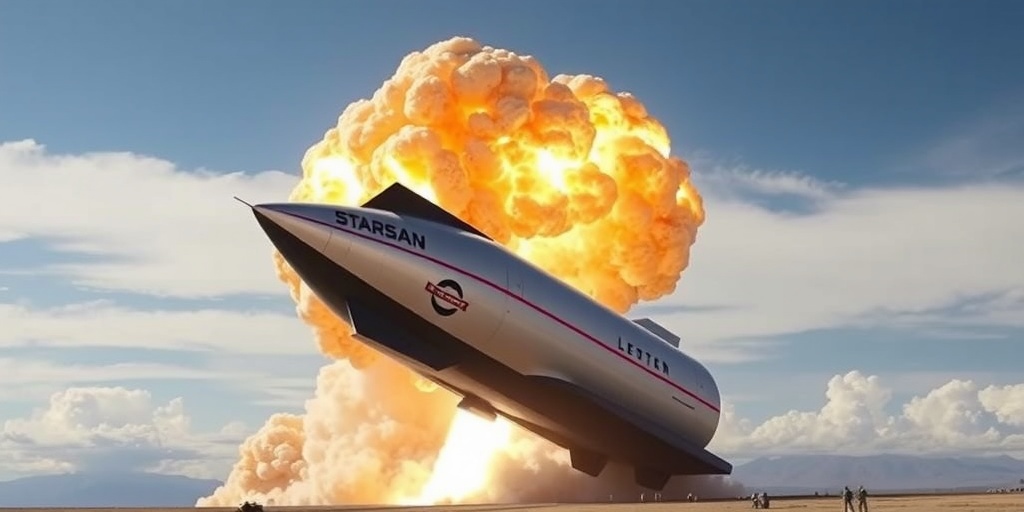Now Reading: F.A.A. Pauses Musk’s Starship Launches Following Explosion
-
01
F.A.A. Pauses Musk’s Starship Launches Following Explosion
F.A.A. Pauses Musk’s Starship Launches Following Explosion

SpaceX Starship Test Flight Ends in Explosion, Prompting FAA Investigation
On Thursday evening, an urgent crisis unfolded at the Federal Aviation Administration (FAA) office in Puerto Rico as a SpaceX test flight of its Starship rocket ended dramatically in an explosion. The incident sent debris cascading down towards the Caribbean, leading air traffic controllers to issue immediate warnings to pilots in nearby airspace. The situation underscored not only the risks associated with commercial space launches but also the potential for significant disruptions in air traffic.
As reports streamed in about the explosion, air traffic controllers announced on the FAA radio system, "Space vehicle mishap," warning flights in the vicinity to steer clear of the area and avoid encountering falling fragments of the rocket. Spectators stationed on islands below, as well as passengers aboard some aircraft, witnessed bright streaks of light as components of the spacecraft plummeted toward the ocean. "We have reports of debris outside of the protected areas," one air traffic controller cautioned, indicating that planes would be held in an alternative airspace until the situation was stabilized.
The disastrous event marked a significant setback for SpaceX, as the Starship spacecraft exploded while still ascending into space. Following the mishap, the FAA promptly halted all future launches of SpaceX’s Starship, which is known as the largest and most powerful rocket ever constructed. The situation raises pressing concerns over the safety protocols surrounding the increasing frequency of commercial space launches and their implications for air travel.
The explosion raised other complexities as well, particularly in light of Elon Musk’s new position within the Trump administration. While Musk is expected to advocate for efficiencies and budget changes across various government agencies, including the FAA, this may raise potential conflicts of interest regarding oversight on investigations related to the incident. Despite the turbulence, Musk expressed optimism that SpaceX would address the issues stemming from the explosion and resume its test flights. On his social media platform X, he remarked, "Nothing so far suggests pushing next launch past next month."
Musk went so far as to make light of the explosion, portraying it as an entertainment spectacle as debris rained down on the Turks and Caicos Islands. He quipped, "Success is uncertain, but entertainment is guaranteed," along with a video capturing the fiery descent of the remnants.
The explosion occurred after the Starship’s second stage had separated from its Super Heavy booster and was traveling at a staggering 13,250 miles per hour, approximately 90 miles above Earth. At the moment of its failure, the Starship was estimated to be over 100 tons in mass, excluding fuel. As the situation unfolded, both SpaceX and FAA officials remained tight-lipped regarding whether the explosion presented a genuine threat to nearby aircraft or individuals on the ground. Reports indicated the agency received no immediate claims of injuries, but an investigation into property damage in Turks and Caicos was underway.
Compounding the chaos, several aircraft that had been instructed to hold in a safer area were forced to divert back to other airports due to low fuel reserves. SpaceX later acknowledged that preliminary data pointed to a fire erupting in the rear section of the Starship, leading to the explosion and subsequent debris fall in a pre-identified hazardous zone. Fortunately, the Starship was at an altitude well beyond that of commercial flights when the explosion occurred, allowing for adequate warning time to prevent any planes from being in jeopardy.
As investigations continue, SpaceX will direct the inquiry into the mishap, with oversight from the FAA. Notably, the FAA could potentially allow SpaceX to resume launches before the investigation’s completion if they can prove that the mishap did not compromise safety. Musk has previously expressed frustration over the prolonged process of securing FAA launch approvals, and his new advisory role is anticipated to lead to expedited reviews of future flight protocols.
Industry experts are beginning to voice their concerns about the rapid increase in launch frequency and its implications for commercial air travel. Todd Harrison of the America Enterprise Institute analyzed the situation, suggesting the new administration might rush the review process for launch licenses. Meanwhile, Tim Farrar, a satellite industry consultant, cautioned against the complications increasing launch schedules might pose, stating, "How much can you realistically increase the tempo of these launches?"
The United States recorded a remarkable 145 launches reaching orbit last year, a significant rise from just 21 five years prior. SpaceX has dominated this surge, conducting 133 of those missions, while other companies have struggled to keep pace. Notably, SpaceX’s Falcon 9 rocket continues to facilitate satellite deployments and national defense payloads, remaining unaffected by the FAA’s recent orders.
In contrast, rival launch company Blue Origin, founded by Jeff Bezos, achieved a milestone of its own during this turbulent time by successfully reaching orbit for the first time with its New Glenn rocket, showcasing the competitiveness of the industry even amid challenges.
With airlines raising alarms about the impact of increasing space launches on their schedules, safety remains the paramount concern. Qantas executives disclosed that they had to delay flights due to space debris from SpaceX’s Falcon 9 launches and emphasized the need for coordination with regulatory entities. As the aviation and space industries navigate this evolving landscape, collaborative efforts will be crucial in ensuring the safety of the skies for all users.
In the wake of this incident, the dual roles of fostering commercial space exploration and ensuring air safety will become increasingly intertwined, and how this balance is achieved remains to be seen. NASA’s Director Bill Nelson praised the importance of the testing efforts, reminding stakeholders that spaceflight complexities persist, making thorough testing vital for future exploration missions to the moon and beyond.
Stay Informed With the Latest & Most Important News
Previous Post
Next Post
-
 01New technology breakthrough has everyone talking right now
01New technology breakthrough has everyone talking right now -
 02Unbelievable life hack everyone needs to try today
02Unbelievable life hack everyone needs to try today -
 03Fascinating discovery found buried deep beneath the ocean
03Fascinating discovery found buried deep beneath the ocean -
 04Man invents genius device that solves everyday problems
04Man invents genius device that solves everyday problems -
 05Shocking discovery that changes what we know forever
05Shocking discovery that changes what we know forever -
 06Internet goes wild over celebrity’s unexpected fashion choice
06Internet goes wild over celebrity’s unexpected fashion choice -
 07Rare animal sighting stuns scientists and wildlife lovers
07Rare animal sighting stuns scientists and wildlife lovers





















